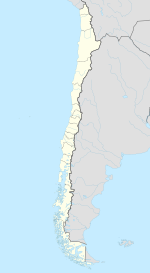Temuco
| Temuco | ||||||
|---|---|---|---|---|---|---|
| City and Commune | ||||||

View of Temuco from Cerro Ñielol
|
||||||
|
||||||
| Coordinates: 38°44′S 72°40′W / 38.733°S 72.667°W | ||||||
| Country | Chile | |||||
| Region | Araucanía | |||||
| Province | Cautín | |||||
| Founded | 24 February 1881 | |||||
| Government | ||||||
| • Type | Municipality | |||||
| • Alcalde | Miguel Becker Alvear (RN) | |||||
| Area | ||||||
| • Total | 464.0 km2 (179.2 sq mi) | |||||
| Elevation | 360 m (1,180 ft) | |||||
| Population (2012 Census) | ||||||
| • Total | 262,530 | |||||
| • Density | 570/km2 (1,500/sq mi) | |||||
| • Urban | 232,528 | |||||
| • Rural | 12,819 | |||||
| Demonym(s) | Temucan | |||||
| Sex | ||||||
| • Men | 117,071 | |||||
| • Women | 128,276 | |||||
| Time zone | CLT (UTC−4) | |||||
| • Summer (DST) | CLST (UTC−3) | |||||
| Area code(s) | 56 + 45 | |||||
| Climate | Csb | |||||
| Website | Official website (Spanish) | |||||
Temuco is a city and commune, capital of the Cautín Province and of the Araucanía Region in southern Chile. The city is located 670 kilometres (416 miles) south of Santiago at the heart of the modern Araucanía Region and historic Araucanía—the land of the Mapuche who resisted Spanish conquest.
Temuco was founded in 1881 during the occupation of Araucanía and grew quickly into one of Chile's main cities. Temuco's central place in Araucanía with easy access to the Andean valleys, lakes and coastal areas makes it a hub for tourism, agricultural, livestock and forestry operations as well as a communication and trade centre for the numerous small towns of Araucanía. Temuco has recently been regarded as a university city as it houses two main universities: University of the Frontier (Spanish: Universidad de La Frontera) and Temuco Catholic University (Spanish: Universidad Católica de Temuco). Nobel laureates Gabriela Mistral and Pablo Neruda both lived in Temuco for some time.
The word Temuco comes from the Mapudungun language, meaning "temu water"; "temu" is the common name of two native trees of the family Myrtaceae, Luma apiculata (also known as arrayán in Spanish) and Blepharocalyx cruckschankii. Both species are characterized by their orange-reddish bark and by having aromatic fruits and leaves which are commonly used by the Mapuche for medicinal purposes. While Blepharocalyx cruckschankii is endangered, Luma apiculata is relatively common and in Temuco it is possible to see it in the Cerro Ñielol Natural Monument (in its natural state) as well as in city gardens and sidewalks. The blend between the words "temu" and "co" (water), probably reflects the fact that these trees frequently grow beside water bodies.
...
Wikipedia




